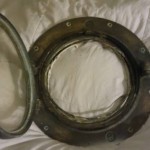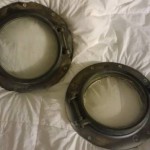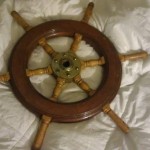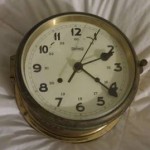I actually mean removing the mast from the boat, not losing the mast at sea, if you were concerned!
After cogitating on this for some time I decided the most straightforward place to put a 35 foot mast is on the roof of the garage. It seems to be a lot easier to shuffle it off the boat onto a few sawhorses spanning the ridge of the garage roof than it is to lower it to the ground and then try to lumber it around the yard, creating a big storage nuisance and knocking over things.
The first step was to clear all of the running and standing rigging. The mast wiring had (unfortunately) been cut at the tabernacle because the yard monkeys couldn’t get the bolt out of the tabernacle. They also found it more expedient to clip the tabernacle bolts than to unscrew them. Anyway…
There were three halyards running through the mast sheaves, which I labeled A B and C. there was also a fourth loose block which was connected to the front of the masthead and moused with stainless wire. I believe this was for at the front of the mast. The A and C sheets were run through the masthead in the same direction. The B sheet went the other way. I don’t know at this point which was which; it could be that B was for the foresail and A and C were Mainsail and topping lift or something. Or maybe the topping lift was wire. I have to look at my old photos and see if I have any details.
All of the sheets are in miserable condition, but I asked the yard to save them so I would have an idea what lengths and sizes I would need. At least two of them are rope as opposed to any kind of yacht braid. I got the two halyards that were wrapped around mast cleats loos and ran them one a time through the sheaves after labeling them. They can only fit through one way because of the splices being bigger than the sheaves. I also have a shackle for each.
After bundling, tagging and zip tying the lines I stowed them away in the aft cabin and moved on to the standing rigging. I had already removed done of the spreaders prior to the trip so I had just one to deal with. It’s something under an inch at the bolt size. I loosened the bolt and we were able to work out the bolt/spacer combination, but the spacer is hopelessly welded to the bolt at this point, so this looks like more hardware that will need replacement. I got the spreader off and stored away. I have the 1″ round spreader poles which I must replace based on their condition. I’d like to replace them with aerodynamic foils. Curt on Journey used new poles and mounts of the original type and ran a wood pole through the pipe to keep them from crushing. I bought two nice spreaders foils Craigslist for $65 but would need to find a way to mount them.
The lines to the spreader tangs were loose so those were coiled, zip tied and stored away. The lines to the upper tangs had to be loosened and removed. The forestay and rearstay lines were removed and coiled.
I believe I have this arrangement of eight wire ropes:
- 1 forestay to the masthead
- split rearstay to the masthead
- 6 sidestays
- inside pair to up the spreader boots to the masthead
- front pair to coupling at the spreader tang
- rear pair to coupling at the spreader tang
The four stays at the masthead were removed by taking out the cotter pins and pushing out the bolts. The nut came off the sidestay but I couldn’t turn the bolt so I had to remove the spreader wires from the tang as opposed to taking off the tang.
The antenna was zip tied down tot the mast.
Free of wire and lines the mask wasn’t unbearably heavy but was rather floppy. Carlos went over to the garage roof and we slid the mast aft about 6 feet to reach him then walked it out about halfway. it became clear he’d need some support on his side as the mast weight increased, so I passed over one of the blocks, which held the mast temporarily while I went to get the sawhorses. I passed all three, one at a time up to him. We arranged the sawhorses across the roof ridge so they were level and got the mast completely off the boat onto the roof of the garage. The center sawhorse sat about an inch lower due to the roof angle, so we blocked up that an inch with a wood block. Then we tied the mast to each of the sawhorses to keep things stable.




![photo 4[1]](http://julesverne.us/wp/wp-content/uploads/2013/03/photo-41-150x150.jpg)
![photo 5[1]](http://julesverne.us/wp/wp-content/uploads/2013/03/photo-51-150x150.jpg)





